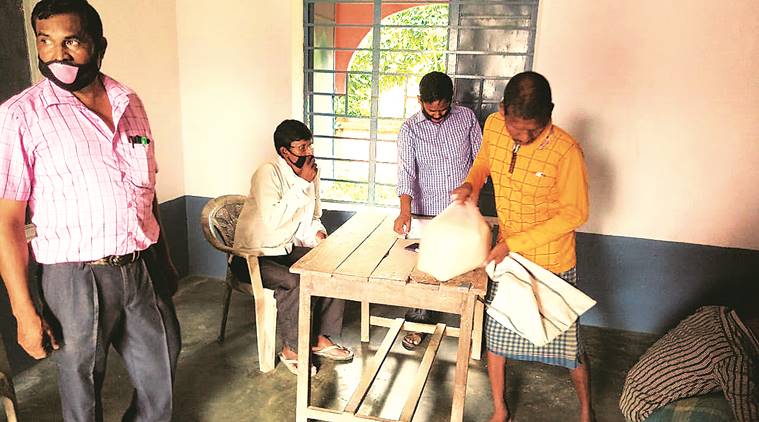 Rice distribution at Shahabad school on Friday. (Express Photo by Dipankar Ghose)
Rice distribution at Shahabad school on Friday. (Express Photo by Dipankar Ghose)
It is clear now that Covid-19 will be here for some time. Schools and anganwadis are closed and children are at home. There is understandable anxiety in the education community. There is no playbook for this situation. Most government schools and anganwadis are small spaces with limited ventilation. There is a lot of discussion about “learning loss”. Fortunately, learning does not happen only in the classroom or from a textbook.
But the problem that must be addressed first, even before learning, is hunger. At a time when one out of three children is malnourished, nutrition must be a priority.
There are different ways of ensuring this. First, even while schools are shut, mid-day meal rations can be distributed every 15 days. But mid-day meals alone cannot address malnutrition. The early years of a child are critical for their health. Hence, the million-plus anganwadis in the country should also be activated. They can distribute take-home rations every 15 days. In containment zones, there should be doorstep delivery. Gram panchayats, which are local governance structures, should oversee this essential activity.
In areas with food insecurity, anganwadis and schools should serve cooked meals. Vegetables should be added to the preparations, especially green, leafy ones. Children can come to school for lunch, as they do during summer holidays in drought-hit talukas. For younger children, parents can pick up the cooked anganwadi meals.
This year, MGNREGA has had a welcome additional allocation. Monsoon is here and it is a good time to create nutrition gardens. Every anganwadi and school should have a kitchen garden with a compound wall. Moringa, especially for its rich nutritive benefits, would be a good tree to plant, apart from fruit trees.
Protein energy malnutrition should also be addressed. Eggs are an excellent source of protein for growing children. Through the rural livelihood programme, women’s collectives can supply eggs to local anganwadis and schools. Women’s collectives can also grow vegetables for anganwadi and school meals.
The first thousand days can determine the trajectory of a child’s life. Pregnant women and breastfeeding mothers should also receive nutrition supplementation. In areas of high food insecurity, they too should receive cooked meals, including protein and green leafy vegetables, either from the anganwadi or from a community kitchen.
The anganwadi is central to the life of a community. Anganwadi workers have not only been making take-home ration kits for young children and new mothers; they have been part of gram panchayat task forces, helping to create awareness about Covid and keep communities safe.
After food for the body is taken care of, we should provide food for the mind. The Greek philosopher Plutarch believed, “Education is not the filling of a pail, but the lighting of a fire.” Early stimulation of a child’s mind through different activities can help them learn constantly. This is the time for early educators and teachers to orient parents in ways to provide stimulating activities for children. This can be done when teachers visit schools and communities, with physical distancing and precautions. One simple sheet with such ideas could be shared with the mid-day meal rations.
It is also a time for community action. For the children in Bhagalpur and everywhere else, local communities should be supported to create small, distributed “learning centres” – groups of not more than five or six children at a time, sitting in a circle with distancing, with a local youth or an older child explaining a topic to them. (On July 2, The Indian Express reported about children of a village in Bhagalpur going hungry after mid-day meals stopped following the Covid lockdown).
Children of migrants who have returned to their villages should now be enrolled in the village school. They should also be included in the learning centres. Children in these learning centres will not only learn about the topic under discussion – they will also learn to build community.
Television should provide programming every day, for an hour, at a fixed time, consisting of five or six different activities: a science activity, some arithmetic, a song, a bit of history, and invariably a children’s story read aloud. This could be at two levels: one for young children, another for older children. The programme should use only locally available material: seeds, leaves, pebbles, matchsticks, newspaper.
This is also a time for professional development of teachers and curriculum reform. Teachers can be given guidance and orientation through WhatsApp, YouTube, or weekly online lessons. Curriculum reform can restructure the syllabus to focus on twenty-first century skills rather than content.
This time should also be used to prepare schools to receive children when they return: painting the walls, planting kitchen gardens, clearing space for playgrounds, building additional toilets, drinking water, electrification, a library. The cost of doing all this will be less than the cost of not doing it.
Twenty years ago, when I met a gram panchayat president during a state-wide literacy programme, he talked to me about Cuba’s literacy programme where teachers and high-school students helped the nation to become literate.
Similarly, this is the time for the education system to innovate and introspect. What is the meaning of learning? What is education? Is it only about decoding a bland paragraph and performing an arithmetic operation? Or is it about curiosity, critical thinking, empathy, collaboration, and solving problems? If that is so, then until the schools can reopen safely, the soil can also be a blackboard, the twigs and pebbles learning resources, and the sky the classroom. If we are able to feed their bodies and enrich their minds, the children will surely build a better world for our collective future.
The writer is in the Indian Administrative Service, and based in Bengaluru.